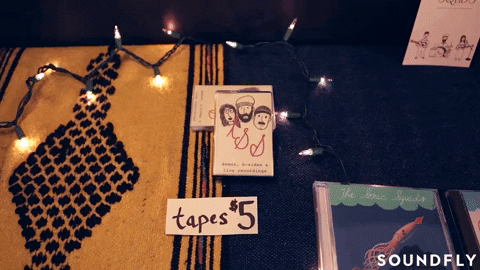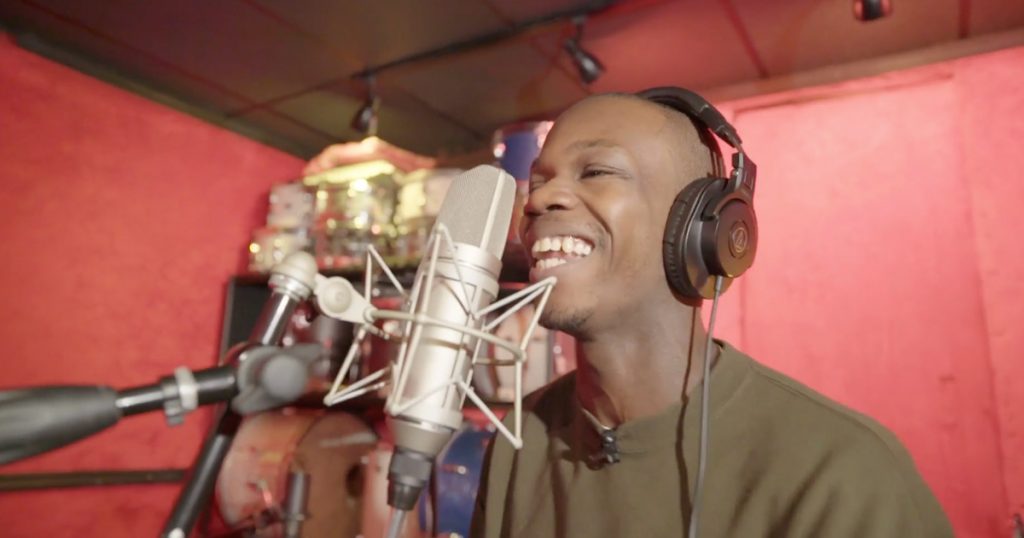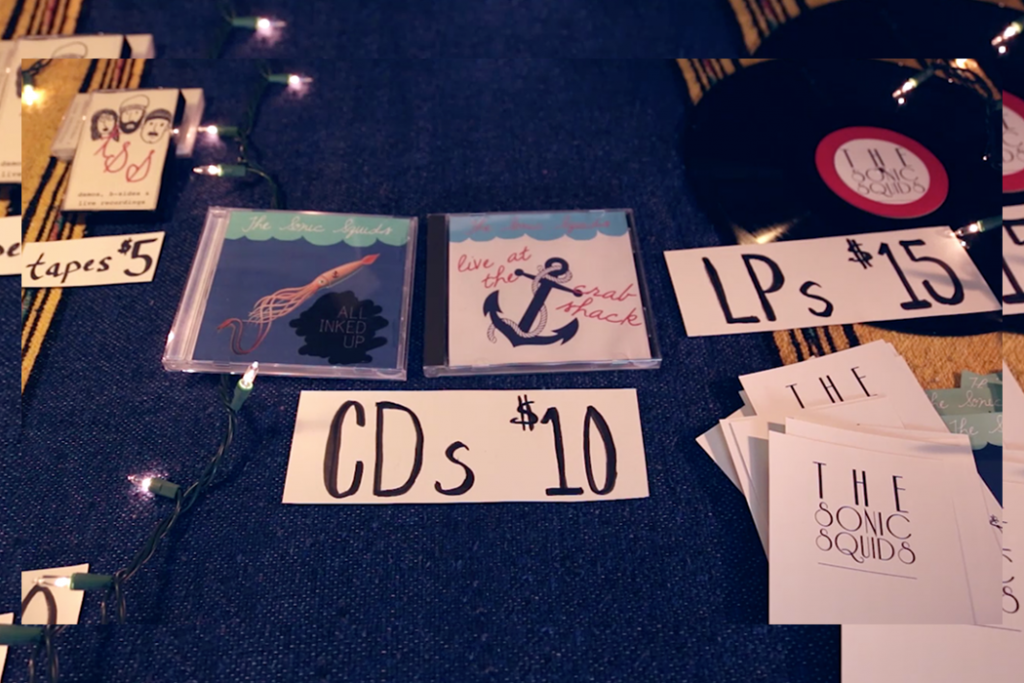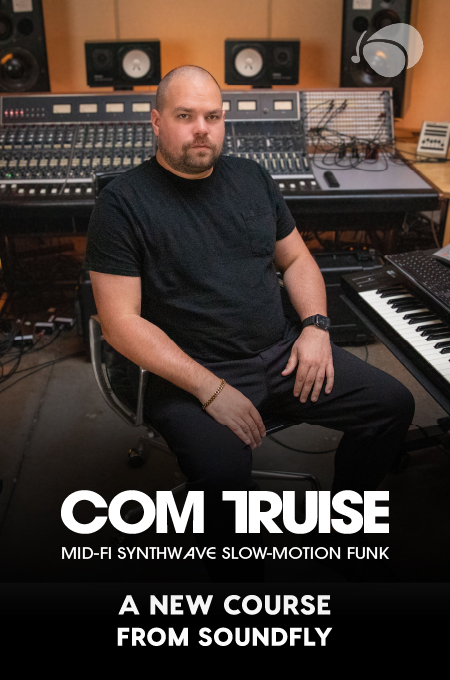+ Did you know that Soundfly’s online course on DIY tour booking, promotion, and management is totally free?! Start learning today.
By Stephen Chen
YES! Someone’s coming up to the merch table. They’ve left their friends back and are approaching you with a smile on their face. “Hey, your band is awesome,” they say, and you exchange pleasantries. You gesture at the T-shirts laid out on your dimly lit merch table, and check your texts: your bandmates are at the bar taking shots. By the time you look up, the prospective buyer is on their way out, clutching a free sticker and nothing else.
With live music slowly coming back, and shows becoming an increasingly regular occurrence here in North America — as the world recovers from this seemingly endless COVID-19 pandemic — I wanted to revisit some of my favorite tips and tricks for working that merch table.
Because, let’s be honest, selling merch is no small task (even in normal show-going times). People go to the grocery store because they need food, but not a show because they need new clothes. And nobody truly needs your physical record if they have an internet connection.

But there’s another way of looking at this: when people come up to the merch table, it’s because they are eager to learn how else they can support your art. They’re going out on a limb to support you by buying something that they don’t really need. They want to buy, you want to sell — enough already, how do we close the deal?
Here are some tips to help you enjoy the hustle.
Tip #1) Have merch that’s at least as cool as your music.
You’ve put effort into creating a musical performance that expresses your identity; why should your merch be any different? Think unique:
- A t-shirt design you can’t get anywhere else,
- Handwritten lyric/art books,
- Recordings that aren’t available online,
- An interactive sculpture,
- Hot sauce,
- Or even better, a crazy idea only your brain could come up with.
Designing merch is also a great opportunity to interact with friends from other artistic disciplines. So think about commissioning a visual artist on merch; you never know where your artistic collaboration might lead.
Tip #2) Create a plan and work as a team.
Too many times I’ve been at a show and wanted to buy merch, but there wasn’t anybody there to sell it to me. So I begrudgingly kept my money and went home. I get it, the post-show deluge gets overwhelming: bandmates need to pack up, new fans want to talk, friends want to buy you a shot, the next band needs to borrow your amp, etc.
But, you only have a few minutes before the audience, still buzzing from your electrifying set, leaves the venue or moves on to something else. You need to create a plan beforehand that allows someone to efficiently get to the merch table with a minimum of distractions.
Consider asking a friend to run your merch table for the few minutes it takes for you to pack up your gear and head over from stage (it’s the least they can do for the guest list spot they asked for):
- Delegate packing-up duties to other band members so you can get off stage quicker, or plan for a lighter rig that can easily be packed up and shuffled off stage.
- Tell people in the audience that you gotta get off stage ASAP but you’ll meet up with them at the merch table in a few minutes.
- And preemptively tell your friends that they’ll have to wait a few minutes for you to finish up with merch before you can hang out.
Tip #3) Sell your merch from stage with conviction.
You can do so much better than mumbling: “we got t-shirts and stuff in the back…” while your guitarist is tuning. Instead, dedicate real time during your set to explaining what your merch is, why people should care, and where they can find it. Even if you only have the typical stickers and T-shirts, there is always something to talk about.
It helps to have an item of merch or two on stage with you so you can show it to the audience, talk about why it’s cool and unique, relate a funny story about it, or anything else that lets your audience develop a connection and familiarity with what you’re selling. And if you lined up a friend who’s going to be helping sell merch after the show, be sure to point them out.
Tip #4) Have merch items at every price point from $0-50.
By the time someone arrives at the merch table, they’ve already decided that they want to give you money, and just need you to show them how. Why limit their options? If a fan doesn’t have much to spend, make sure you have something under $10 so they can at least walk away with something.
Remember, they can always just find your music for free online. But for fans who were blown away by your set, have deep pockets, or ideally both, you should have one-of-a-kind specialty items pushing $30, even $50.
+ Learn production, composition, songwriting, theory, arranging, mixing, and more; whenever you want and wherever you are. Subscribe for full access!

Tip #5) Show and tell.
Why just sell someone a t-shirt? Why not a super-comfy t-shirt that’s pre-shrunk, that just came in last week, with a design that was custom-made by your cool friend? Details help! They differentiate your merch from the million other things that are being sold to us at every moment of the day.
To take things a step farther, inject your own personality and opinions into it. Tell people which merch item or shirt design is your favorite, and why. It’s a unique opportunity to draw a personal connection between you, the fan, and the merch item that they’re just waiting to convince themselves to buy. (Just think of how compelling it is when a waiter makes a detailed recommendation at a restaurant!)
Tip #6) Encourage people to interact physically with the merch.
“Merely touching an object results in an increase in perceived ownership of that object,” say the authors of this study on consumer behavior. It may seem obvious, then, to let people pick up your CD and examine it, but why settle for that when you can pick it up yourself and hand it to them? Do they want to try on a t-shirt and see how it looks? Sure!
Also, if you have multiple people at the table, this can help preemptively answer other peoples’ questions (i.e: “which album has that song on it?”), and reduce the wait!
Tip #7) Hustle and be personable.
Once you’ve become comfortable with interacting and selling to the fans that voluntarily come up to you, it’s time to conquer your fears and go after more sales. While you may be shy to talk to strangers about what you’re selling, the ironic thing is that many concert-goers remain strangers because they are shy themselves. They say “great set!” and walk away, secretly wishing they had the guts to go up and talk to you. You can break that shyness just with a few easy lines; you will not believe the gratitude on some people’s faces once you show them that you are interested in chatting with them!
When someone says “great set,” throw them a lifeline and simply say something along the lines of “hey thanks! What was your name?” or “Thanks, how did you hear about the show?” Any sort of easy-to-answer question invites them up to the table, where you can then work your magic.
Tip #8) Selling isn’t everything.
These tips have leaned heavily on how to drive more merch sales, but to take a step back, remember the whole point of why you do any of this. Most of us create indie music to create relationships between your artistry and an audience. So, cherish each conversation with every fan.
Regardless of whether they buy something from you, everybody who comes up to your merch table is voluntarily taking the extra step to learn more about you and your art. The relationships and even friendships that can blossom out of merch table interactions are a perfect illustration of how art can enrich the human experience.
Besides, you never know who will come back to your next show with a millionaire relative in tow!
Don’t stop here!
Continue learning with hundreds of lessons on songwriting, mixing, recording and production, composing, beat making, and more on Soundfly, with artist-led courses by Kimbra, Jlin, Kiefer, RJD2, Ryan Lott, and of course, Com Truise: Mid-Fi Synthwave Slow-Motion Funk.
—
Stephen Rodes Chen is a saxophonist and producer based in Brooklyn NY. He plays saxophone in San Fermin, Ghost Funk Orchestra, and leads his own experimental-pop band Behaviorist.




